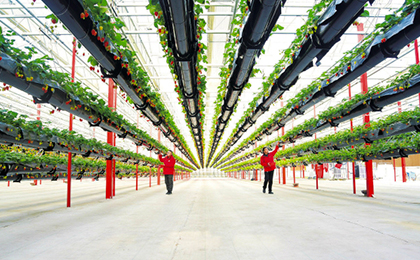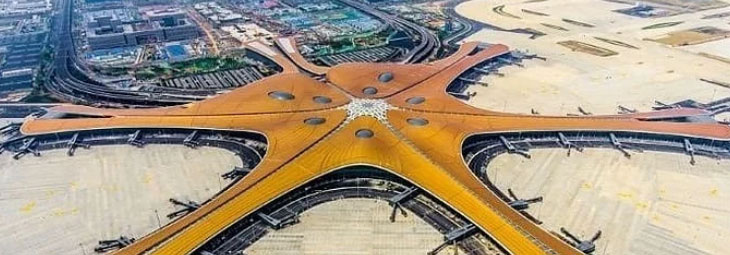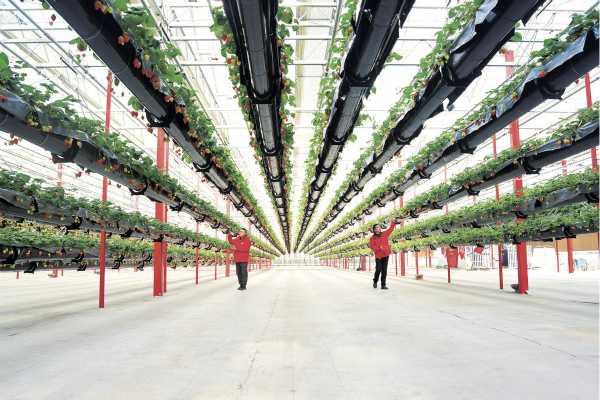


The 14th Five-Year Plan period (2021- 2025) is the first five years in which China will advance toward the Second Centenary Goal on its new journey to become a modern socialist country. During a meeting of the Political Bureau of the CPC Central Committee held on February 26, 2021, it was stressed that rationally formulating and implementing an outline for the 14th Five-Year Plan (2021-2025) and long-range objectives through the year 2035 under the leadership of the CPC while effectively exerting the strengths of the Chinese socialist system is of major significance for consolidating and expanding upon our achievements in building a moderately prosperous society in all respects and winning the fight against poverty, as well as launching our new journey toward becoming a modern socialist country. The Fifth Plenary Session of the 19th CPC Central Committee reviewed and adopted the Recommendations of the Central Committee of the Communist Party of China for Formulating the 14th Five-Year Plan for Economic and Social Development and Long-Range Objectives through the Year 2035 (referred to below as the "Recommendations"), charting the course and providing guidelines for drawing up the plan. In accordance with the decisions and plans of the CPC Central Committee and the State Council, the National Development and Reform Commission made arrangements for formulation of the draft Outline for the 14th Five-Year Plan for Economic and Social Development and Long-Range Objectives Through the Year 2035 (referred to below as the "Outline"), which was reviewed and approved at the Fourth Session of the 13th National People's Congress.
The Outline is consistent with the spirit of the Central Committee's Recommendations, and upholds the guiding role of Xi Jinping Thought on Socialism with Chinese Characteristics for a New Era. It highlights the core points of the "three news," namely grounding ourselves in this new stage of development, applying the new development philosophy, and forging a new development dynamic, as well as the linkage between efforts to effectively fulfill the Two Centenary Goals. It also puts forward explicit concepts, principles, and strategies, which together form the guidelines for economic and social development during the 14th Five-Year Plan period. On this basis, the Outline articulates concrete quantitative goals and defines the main targets.

The CMHI-16302 semi-submersible heavy-lift platform built by China Merchants Heavy Industry (Jiangsu) Co., Ltd, one of the most advanced of its kind in the world, pulls away from the Port of Taicang in Jiangsu Province, February 21, 2021. PEOPLE'S DAILY / PHOTO BY JI HAIXIN
The guidelines put forward in the Outline further clarify the overall approach for economic and social development during the 14th Five-Year Plan period.
With the goal of promoting high-quality development during the 14th Five-Year Plan period and better reflecting the essence of the "three news," a number of new requirements are stressed in the Outline's guiding concepts. The first is resolutely applying the new development philosophy. The new development philosophy is a well-structured theoretical system, which addresses a whole series of theoretical and practical questions on what the goals, drivers, methods, and approaches for development are in this new stage of development. The philosophy must be applied in every area and throughout the entire process of development. The second is sticking to the theme of promoting high-quality development and focusing on the main task of boosting supply-side structural reform. At present, the problems facing China's development are primarily manifested in the quality of development, and therefore it is imperative to ensure that the demand for higher quality permeates all sectors, including the economic, social, cultural, and environmental sectors. Meanwhile, in continuing supply-side structural reform, our efforts are focused on improving the supply system and promoting a better dynamic balance between supply and demand. The third is making reform and innovation the fundamental drivers. Reform, opening up, and innovation are the wheels carrying forward our efforts to pursue high-quality development and build a modern economic system. We must continue to use reform and innovation as a means of overcoming developmental hurdles, responding to external challenges, and making progress toward general long-term goals. The fourth is pursuing the fundamental objective of meeting the people's growing desire for a better life. This objective is an ample illustration of our people-centered approach to development. We must ensure that development is for the people, reliant on the people, and that its fruits are shared among the people, and work hard to effectively address all kinds of real issues related to public wellbeing. The fifth is moving faster to develop a new development dynamic featuring the flows mainly of the domestic economy while the domestic and international flows are mutually reinforcing. This represents an important decision made by the CPC Central Committee in light of changing circumstances as well as China's stage of development and development environment. While taking both the domestic and international situations into account and balancing development and security imperatives, we must effectively execute all initiatives in order to ensure that China gets off to a good start on its journey toward socialist modernization.

Workers pick strawberries at a smart greenhouse in the town of Yangcunqiao, Jiande, Zhejiang Province. In recent years, the town has pushed forward with transformation and upgrading of agriculture, which has helped strawberry farmers apply digital technology in production and sales while boosting agricultural output and income.
PEOPLE'S DAILY / PHOTO BY NING WENWU
With the aim of better implementing these guiding concepts for development, the Outline was formulated to be matched and consistent with the Recommendations, and further emphasizes the five major principles that economic and social development must follow during the 14th Five-Year Plan period, namely exercising all-round Party leadership, continuing to take a people-centered approach, applying the new development philosophy, continuing to further reform and opening up, and continuing to apply systems thinking.
The Outline takes aim at the long-range objectives through the year 2035, further specifying the goals and targets for economic and social development during the 14th Five-Year Plan period.
In line with the strategic arrangements in the Recommendations for building a modern socialist country in all respects, the Outline clearly describes the long-range objectives for basically achieving socialist modernization by 2035 on nine different levels. Meanwhile, with a focus on tasks for different stages of the 14th Five-Year Plan and on the six requirements described in the Recommendations, the Outline further specifies and solidifies the major objectives for economic and social development during the 14th Five-Year Plan period with regard to economic development, reform and opening up, public civility, ecological conservation, people's wellbeing, and the effectiveness of governance. It also sets 20 main targets in the areas of economic growth, innovation-driven development, people's wellbeing, environmental protection, and security safeguards. These targets fully reflect the requirements of the new development philosophy, and are fully linked with the system of targets for high-quality development.
The Outline introduces strategic tasks and key measures in 17 different areas. These are aimed at resolving major challenges that we face in the course of economic and social development, and take into account both the major issues of the state and minor matters that are nonetheless of critical importance. They reflect our overall grasp on the new stage of development, the new development philosophy, and the new development dynamic, and should be executed and implemented in a systematic and integrated manner.
Remaining committed to innovation-driven development and accelerating the development of a modern industrial system
Innovation is the prime mover of economic development, and holds a place at the heart of China's modernization drive. The Outline regards innovation-driven development a top priority, and emphasizes the need to make scientific and technological self-reliance a strategic pillar of national development and to advance scientific and technological innovation, industrial development, and digital transformation in a coordinated manner. We must move faster to build China's strength in science and technology, bolster our strategic scientific and technological abilities, build a new type of system for pooling the nation's resources under the conditions of a socialist market economy, boost enterprises' capacity for scientific and technological innovation, stimulate the innovative energy of talented people, improve systems and mechanisms for scientific and technological innovation, and foster new strengths in development across the board. We must consolidate and expand the foundations of the real economy, thoroughly implement the strategy to turn China into a manufacturing powerhouse, move forward with upgrading industrial foundations and modernizing industrial chains, keep the manufacturing sector's share in the economy relatively stable, promote innovative development of strategic emerging industries, expand effective supply in the service sector, and accelerate the development of a modern industrial system. Finally, we must vigorously promote digital development, augment the innovative application of key digital technologies, push forward digital industrialization and the digital transformation of industries in a coordinated manner, pick up the pace in developing a digital society, foster a more digital government, and build a digital China.
Forming a robust domestic market and fostering a new development dynamic
Fostering a new development dynamic is a systemic, thoroughgoing reform with far-reaching implications. It represents a strategic choice to forge a new edge for China in economic cooperation and competition on the global stage. With the domestic and international development environments changing in profound ways, it is crucial for us to ground our development in the domestic sphere and rely more on the domestic market to achieve economic growth. The Outline states that we must remain focused on the key strategic objective of expanding domestic demand, and integrate this strategy with efforts to continue supply-side structural reform. We must ensure unimpeded flow in the domestic economy, adapt to new demands from the upgrading of industry and consumption, build a strong domestic market, link together production, distribution, and consumption, continue increasing the supply of premium products and services, clear out blockages restricting the flow of factors, effectively eliminate local protectionism, industry monopolies, and market barriers, and form a better dynamic balance in which demand guides supply while supply creates demand. We must promote the dual circulation of domestic and international economic flows, advance the development of our robust domestic market and our trading capacity in a coordinated manner, push forward coordinated growth of imports and exports, refine the unified regulatory system for domestic and foreign trade, diversify the source of imports, improve the quality and composition of export goods, enhance incoming and outgoing investment, champion the development of bilateral and multilateral mechanisms for cooperation on investment, take steps to ensure that domestic and international economic flows are mutually reinforcing, and continue to make the Chinese economy more attractive to global factors and resources and more competitive in the world market. We must move faster to cultivate a complete domestic demand system, thoroughly implement the strategy to expand domestic demand, and work quickly to refine systems and mechanism that encourage rational consumption, saving, and investment. We should upgrade traditional forms of consumption, foster new forms of consumption, grow consumption of services, and appropriately increase public consumption, so as to bolster the fundamental role of consumption in economic growth. We should also step up investment to address shortcomings, push ahead with major projects related to new forms of infrastructure, new urbanization, transportation, and water conservancy that will not only boost consumption and benefit the people, but also facilitate structural adjustment and enhance the sustainability of growth, and add to the key role of investment in optimizing the supply structure.
Advancing rural revitalization and refining the new urbanization strategy
Agriculture and rural areas are where the most improvement is needed in the modernization drive, while urbanization holds the greatest potential for domestic demand. The Outline states that we must fully implement the rural revitalization strategy, make deeper progress with the new urbanization strategy, and facilitate the establishment of a new type of relations between industry and agriculture and between urban and rural areas in which industry and agriculture promote each other, urban and rural areas reinforce each other, and all-round integrated development and common prosperity is achieved. We must continue to prioritize the development of agriculture and rural areas, continue supply-side structural reform in the agricultural sector, stick to the red line of ensuring that 120 million hectares of land are reserved for agriculture, launch projects for chernozem soil conservation and rural development, and effectively link rural revitalization with efforts to consolidate and expand upon the outcomes of the fight against poverty. We must expedite the full integration of migrants from rural areas in cities where they now work and live, prioritizing those who are already living in urban areas as permanent residents. We must advance efforts to reform the household registration system and ensure that all permanent urban residents are covered by basic public services, ease restrictions on attaining resident status in cities with the exception of a few megacities, and conduct trials for a system where household registration is based upon one's regular place of residence. We must improve the spatial layout through urbanization, develop and expand city clusters and metropolitan areas, provide guidance to cities on the direction and focus of their development based on their size, encourage megacities to become leaner and more streamlined, make medium-to large-sized cities more comfortable places to live and work, and promote urban development in which county towns are important vehicles. We must improve urban environment, coordinate urban planning, construction, and management, launch urban renewal initiatives, push forward the renovation of aging residential compounds in urban areas, and enhance the housing market and housing support systems.

Goods are unloaded from ships using massive cranes at a container terminal in the Port of Lianyungang, Jiangsu Province, January 14, 2021. Openness is crucial for the country to thrive. During the 14th Five-Year Plan period, China will open up across more sectors and in a more thorough fashion, unlocking new prospects for mutually beneficial cooperation.
PEOPLE'S DAILY / PHOTO BY WANG JIANMIN

Two Indo-Pacific humpback dolphins, which are national Class I protected wild animals, play near the shore in Nanwan Village, Xiapu County, Fujian Province, March 1, 2021.
PEOPLE'S DAILY / PHOTO BY ZHENG PEILUAN
Optimizing the regional economic layout and promoting coordinated regional development
Reducing the disparities in development between regions is an objective requirement for optimizing the layout of China's territorial space under high-quality development. The Outline states that we must thoroughly implement major regional strategies, the coordinated regional development strategy, and the functional zoning strategy, refine systems and mechanisms for coordinated regional development, and develop a high-quality regional economic layout and a territorial space supporting system. We must optimize the layout for development and protection of our territorial space, leverage the comparative strengths of each area on the basis of their resource and environmental carrying capacity, implement the functional zoning system, enhance the supportive capacity of regions with important functions, and actively create more room for growth of the maritime economy. We must promote new breakthrough progress on major regional strategies, accelerate coordinated development of the Beijing-Tianjin-Hebei Region, comprehensively advance development of the Yangtze River Economic Belt, drive active yet steady progress in development of the Guangdong-Hong Kong-Macao Greater Bay Area, boost integration in the Yangtze River Delta, and take concrete steps to promote ecological conservation and high-quality development in the Yellow River basin. We must thoroughly implement the coordinated regional development strategy, push on with work to create a new pattern of large-scale development of the western region, make breakthroughs in revitalizing the northeast region, open up new prospects for the rise of the central region, encourage the eastern region to pick up the pace of modernization, and support the development of regions with unique features, promoting relative balance through development.
Comprehensively deepening reform and opening up and continuing to boost the impetus and vitality of development
Reform and opening up is the game changing move that has made China what it is today. The Outline states that we must uphold and improve our basic socialist economic system, pursue better integration between an efficient market and an effective government, promote opening up across more sectors and in a more thorough fashion, and unlock new prospects for mutually beneficial cooperation. We must build a sophisticated socialist market economy, maintain a steadfast commitment to developing both the public and non-public sectors of the economy, accelerate improved distribution and structural adjustment in the state-owned sector, promote high-quality development of private enterprises, and stimulate the vitality of all types of market entities. We must build a high-standard market system, carry out comprehensive improvement of the property rights system, push forward reforms for the market-based allocation of factors, enhance the social credit system, and form a unified, efficient, and standardized domestic market that features fair competition. We must step up efforts to foster modern fiscal and financial systems, accelerate the transformation of government functions, create new and better means of macro regulation, establish a first-rate business environment, and raise the government's administrative capacity with regard to economic affairs. We must put the policy of opening up to high standards into practice, leverage the advantages of China's massive market, develop new institutions for a more open economy, enhance the functions of platforms for opening up, improve the balance in opening our different regions, and promote the liberalization and facilitation of trade and investment. We must encourage high-quality cooperation with regard to the Belt and Road Initiative, link development strategies and policies more closely, deepen pragmatic cooperation, reinforce security safeguards, and promote shared development. Finally, we must actively participate in reforming and building the global governance system, and promote joint efforts to develop a global community with a shared future.
Promoting green development and cultivating harmony between humans and nature
Building an eco-civilization is vital to sustain the Chinese nation's development. The Outline states that we must uphold the notion that lucid waters and lush mountains are invaluable assets, remain committed to respecting nature, following its ways, and protecting it, carry forward the Beautiful China initiative, and promote harmony between humans and nature. We must strive toward overall improvement in our natural ecosystems, continue our holistic approach to the conservation of mountain, river, lake, forest, farmland, and grassland ecosystems, improve the system of shields for ecological security, establish a system of nature reserves, refine mechanisms for ecological compensation, and constantly enhance the quality and stability of our ecosystems. We must continue to improve environmental quality, make penetrating advances in the battle to prevent and control pollution, raise the quality of environmental infrastructure, formulate an action plan for bringing carbon emissions to a peak before 2030, refine systems for controlling energy consumption in terms of both amount and intensity, and actively respond to climate change. We must expedite the transition to more environmentally friendly methods of development, prioritize the environment and uphold green development, see that high-quality development coincides with high-level environmental protection, halt expansion of projects of high emission and excessive energy consumption, and take comprehensive steps to ensure that resources are used more efficiently.
Continuing to improve public wellbeing and taking solid steps toward common prosperity
Public wellbeing is the basis of social harmony and the greatest test of political efficacy. The Outline puts focus on well-rounded human development and improving public wellbeing, and stresses that we must do everything within our capacity to ensure that the basic needs of all are met, that the people share more fully and fairly in the fruits of development, and that they have a stronger sense of fulfillment, happiness, and security. We must make it a priority to cultivate the character of our citizens, build a high-quality education system and a comprehensive healthcare system covering all stages of life, and promote balanced, high-quality development and urban-rural integration in compulsory education. We must develop a strong public health system, and expand the supply of medical services and resources. We must implement proactive state policies for responding to population aging, vigorously develop inclusive eldercare services, make the best use of the demographic dividend, cultivate better human resources, and boost capacity for well-rounded human development. We must raise quality and standards with regard to public services, move faster to remedy shortcomings in basic public services, and devote energy to addressing weaknesses in non-basic public services. We must implement the employment first strategy, expand employment capacity, and provide better jobs. We must step up efforts to develop a multi-layered social security system that is unified, fair, and sustainable and that covers all citizens in both urban and rural areas. We must raise the proportion of primary distribution accounted for by wages, continue to increase incomes among low-income earners, expand the size of the middle-income group, and promote common prosperity in a more proactive manner. We must develop advanced socialist culture, and make further efforts to foster a great socialist culture in China while also carrying forward the best of traditional culture of the Chinese nation. We must push forward integrated development of urban and rural systems for public cultural services, bolster international exchanges and intercultural dialogue on multiple levels, and enhance the influence of Chinese culture. Finally, we must expand the supply of top-quality cultural products, promote the integrated development of culture and tourism, and improve systems of industries and markets in the cultural sector.
Balancing development and security and carrying out the Peaceful China Initiative more effectively
Security is a precondition of development, while development is a guarantee of security. The period before us is one in which we will be extremely susceptible to all manner of risks and challenges. It is therefore essential that we think in terms of worst-case scenarios so that we can fend them off effectively. For the first time, the Outline includes a section dedicated to safe development, which stresses that we must maintain a holistic approach to national security, put our national security strategy into practice, apply the concept of safe development in all aspects of national development, enhance the development of our national security systems and capacity, and forge strong shields to keep China safe. We must strengthen safeguards for our nation's economic security, enhance early warning on economic security risks as well our mechanisms and capacity for responding to them, and ensure a tight grip on security in key areas such as critical industries, infrastructure, strategic resources, and key technologies. We must implement our food security strategy, focus on land and crop varieties, implement the food crop production strategy based on farmland management and the application of technology, promote breakthroughs on critical seed technology, and ensure that basic food supplies are absolutely secure, that we are largely self-sufficient in grain, and that there is an abundant supply of secondary agricultural products. We must implement our energy and resource security strategy, continue to emphasize domestic supply while remedying shortcomings, establishing diversified guarantees, and bolstering reserves, improve our energy and resource production, supply, reserve, and sales systems, and boost our capacity to provide a steady and sustainable supply of energy and to manage related risks. We must implement our financial security strategy, and resolutely guard against systemic risks. We must comprehensively enhance our capacity to safeguard public security, remain committed to protecting the people and protecting life above all else, improve public security-related systems and mechanisms, and guard the people from mortal danger. We must improve and enforce the system of accountability for workplace safety, enhance end-to-end oversight on food and drug safety, and develop systems for countering biosecurity risks. We must upgrade our emergency management systems, and boost our capacity for disaster prevention, mitigation, and relief. We must keep society stable and secure, properly handle problems among the people in the current era, and build a smart, comprehensive, and multifaceted web for public safety. Finally, we must uphold and develop the Fengqiao experience, refine mechanisms for tackling social problems in a comprehensive manner, and promote the modernization of our crime prevention and control systems.
The Outline also touches upon other issues including development of national defense and the armed forces as well as democracy and the rule of law, and lays out plans for 102 major projects including future-oriented projects concerning key challenges, world-class infrastructure projects with landmark significance, and important projects for ensuring public wellbeing. We must work to ensure that projects stick to their respective plans and that funds and factors follow projects so that these major projects are effectively implemented and our plans yield positive results.
(Originally appeared in Qiushi Journal, Chinese edition, No. 6, 2021)